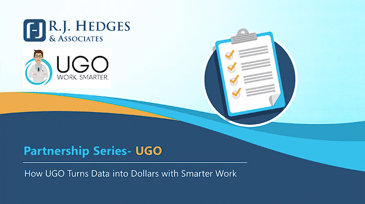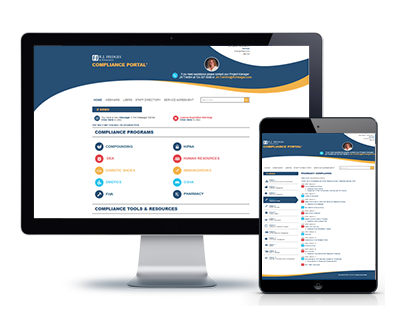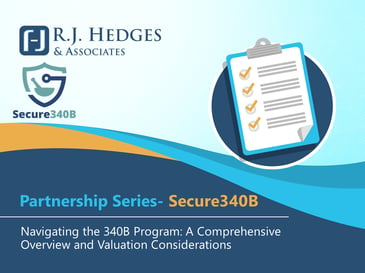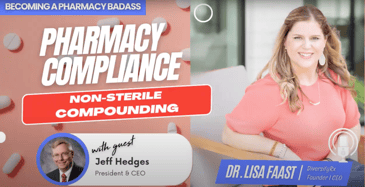
USP 800 Hazardous Drug Compliance Program
Independent pharmacies – did you know NIOSH just changed the rules? New drugs were added and categories shifted. That means your Assessment of Risk might need a serious update. Good news: we already built the solution for you. Check it out here!
We understand it's hard to keep up with regulations; when they start, what they mean, what needs to be implemented, and when they change.
At R.J. Hedges & Associates, we are here to keep you stress-free and in compliance! Our comprehensive program is built to support independent retail pharmacies with everything required to implement USP <800> (Hazardous Drug) standards.
The R.J. Hedges Hazardous Drug Compliance Program Includes:

- Assessment of Risk
- Hazard Communication Plan
- Hazardous Drug Inventory
- Hazardous Drug Training
- Policies & Procedures including Final Dosage and Best Practices
- Updates when Regulations Change
- 24/7 Access to files via Compliance Portal®
- Designed for Retail and LTC Pharmacies
The R.J. Hedges Hazardous Drug Compliance Solutions available for purchase:
Hazardous Drug Compliance Program
-
- A complete Hazardous Drug Manual with step-by-step guidance, Policies & Procedures, Support Documents, and Trainings
- Policies fully aligned with USP <800> requirements
- Includes staff roles, workflow recommendations, exposure protocols, and more
- Designed for easy on-boarding and inspection readiness
Ready-to-Use Assessments of Risk (AoR) for Retail Only Pharmacies
-
- Over 265 AoRs built on the updated NIOSH Hazardous Drug List
- Customized and delivered via your Compliance Portal
- Tracks 5 years of annual review and signatures
- Automatically updated when drug classifications change
- Includes FREE access to a Hazardous Drug Spill Kit (just pay shipping), while supplies last
Spill Kit – Be Prepared for Exposure Incidents
-
- Meets USP <800> spill response requirements
- Includes everything your staff needs to safely manage accidental exposure
- Will meet USP <800>, OSHA, and EPA requirements and can be used for any spill including bodily fluids
Hazardous Drug Labels – Keep Your Shelves Organized & Safe
-
- Bright, durable labels to clearly mark HDs in your inventory
- Helps staff quickly identify and safely handle these medications
- Supports storage, transport, and dispensing protocols under USP <800>
Do you do Compounding?
We didn't forget about you, but we do have a solution specifically geared for compounding pharmacies as they have a lot more requirements. Be sure to ask about our Compounding Compliance solution.

We have been associated with R.J. Hedges & Associates since 2009. We have the utmost respect for R.J. Hedges and his team! We are an Independent Pharmacy, and having to maintain compliance with a number of organizations including CMS with Medicare, State Board of Pharmacy, DEA, FDA, USP<800> and State Medicaid Programs. We are extremely pleased with the services we have received from R.J. Hedges & Associates. They are always on top of mandatory changes within the programs, and they make it easy for the Independents to keep up with the current Policies & Procedures to be compliant and accredited. One may argue of the cost of their services, but we feel it is an investment into out business!
Brenda J. Weber, R.Ph.
Clearfield Pharmacy
Why You Need a Hazardous Drug Compliance Program, Even If You Don’t Compound
What is USP <800> and does it apply to my pharmacy?
USP <800> is a nationally recognized set of standards for handling hazardous drugs (HDs) in healthcare settings—including retail pharmacies. It’s where State Boards of Pharmacy and the FDA look for compliance guidance. If your pharmacy dispenses medications listed on the NIOSH Hazardous Drug List, then USP <800> applies to you, even if you don't compound.
What happens if I don’t follow USP <800>?
USP <800> is no longer “nice to have”—it’s a compliance expectation that’s being enforced across the country.
Failure to follow USP <800> can lead to:
-
- Board of Pharmacy citations
- Failed inspections
- Increased liability for staff and patient exposure
- Gaps in documentation that can trigger deeper audits
What do I need to have in place to be compliant?
A fully compliant Hazardous Drug program includes:
-
- A written Hazardous Drug Policy & Procedure Manual
- Completed and signed Assessments of Risk for all HDs you dispense
- Documented annual reviews
- Clearly labeled hazardous drugs on your shelves
- A properly equipped Spill Kit ready to use in case of exposure
- Staff training and easy-to-access support documents
I don’t compound—do I still need a Hazardous Drug Program?
Yes—if you dispense medications that appear on the NIOSH list, you are required to:
-
- Perform an Assessment of Risk for each HD
- Document and review them annually
- Follow safe handling and labeling practices
Compounding pharmacies must follow the full USP <800> standard. Retail pharmacies, however, can use Assessments of Risk to comply through an alternative path—but only if the paperwork is done properly and completely.
How can R.J. Hedges & Associates help me get compliant—quickly and correctly?
We’ve created a fully integrated Hazardous Drug Compliance Program that includes everything you need to be confident and compliant, whether you’re a retail or compounding pharmacy. Our team has already done the research, built the documents, and structured the program so that all you have to do is review, implement and sign. Task lists will be shared each month that highlight items your pharmacy needs to do. We take everything a pharmacy must complete annually and divide it into 12 task lists to make integration easier. Some months you won't have any requirements for this program, others you may need to review documents or complete annual training.
Why Do I need Completed Assessments of Risk?
The Long Answer: Completing and maintaining AoRs is essential for pharmacies to manage hazardous drugs safely and in compliance with regulatory standards. Under USP <800>, pharmacies that handle hazardous drugs (HDs) must either implement all specified containment strategies or perform a documented Assessment of Risk (AoR) for each HD. (OSHA- Controlling Occupational Exposure to Hazardous Drugs) Without a completed AoR, all HDs must be stored and handled in full compliance with USP <800> containment requirements, which include:
These measures are designed to minimize occupational exposure to hazardous drugs and ensure the safety of healthcare workers. Performing and documenting an AoR allows pharmacies to identify alternative containment strategies and work practices for specific HDs, potentially reducing the need for some of the more stringent containment measures. However, if an AoR is not conducted, the pharmacy is required to adhere to all containment strategies outlined in USP <800> for every HD handled.
The Short Answer: Because USP <800> requires it—and inspectors are looking for it. If your pharmacy dispenses any medications listed on the NIOSH Hazardous Drug List, you must complete an Assessment of Risk (AoR) for each one or follow the full USP <800> handling standards (which are far more stringent and time-consuming). Without completed and signed AoRs on file, your pharmacy is not compliant, even if you use gloves and safety precautions. It’s the documentation that proves your processes meet USP <800> standards and protects you during an inspection.
Most Frequently Asked USP <800> Questions by Independent Pharmacies
- General
- Identification / Inventory
- Segregation / Storage
- Hazardous Drug Handling / Personal Protective Equipment
- Safety Data Sheet (SDS)
- Assessment of Risk
- Disposal
- Google Most Frequently Searched
-
Is USP <800> just for compounding?
USP <800> affects all types of pharmacy operations including retail pharmacy, LTC pharmacy, compounding pharmacy, and every other facility with the word pharmacy associated with it because every pharmacy has the ability to handle and dispense hazardous drugs. Failure to comply with USP <800> can impact both your pharmacy license and the pharmacist-in-charge license. Please beware that USP <795> and <797> is fully implemented and enforceable on Nov 1, 2023; thus all state regulators waiting to enforce USP <800> until those 2 items were out of committee will now be enforcing USP <800>.
Is this a federal or state requirement?
USP <800> is a federal requirement that will be enforced by the State Board of Pharmacy and the State Department of Environmental Protection.
Do we need a separate binder for the Hazardous Drugs and the Assessments of Risk?
We recommend that Assessments of Risk be maintained in a separate binder so that the information is readily available for state inspectors.
-
Do I need to write down the drugs we have that are just listed on the NIOSH list? For example, ketoprofen is NOT on the NIOSH list; however, it is considered hazardous and has an extra hazard shipping charge.
A drug may be classified as a hazardous drug, a hazardous material, both a hazardous drug and a hazardous material, or neither a hazardous drug nor a hazardous material. Hazardous drugs are classified by the U.S. Department of Health & Human Services using the NIOSH standards, and, therefore, must be included on your list as you identify and inventory USP <800> Hazardous Drugs in your pharmacy.
Hazardous materials are classified by the U.S. Department of Transportation and use a completely different set of standards related to shipping. Therefore, a drug that is NOT on the NIOSH List but that carries a hazard shipping charge, for example, ketoprofen, would not be included in your USP <800> Hazardous Drugs Inventory list.
Do we need to list hazardous drugs that we had in our inventory in the past or only currently and moving forward?
Any/all hazardous drugs currently in your pharmacy must be included in your Hazardous Drugs Inventory list. The Hazardous Drugs Inventory list should be updated when a new hazardous drug is received. There is no need to include previous hazardous drugs that are no longer in inventory.
What if I don’t manipulate the drug in any way? Does it still need to go on my Hazardous Drugs Inventory list?
Yes, any drug on the NIOSH List that is in your pharmacy must be included on your Hazardous Drugs Inventory list.
Is warfarin on the hazardous drugs list?
Yes, warfarin is listed as a Table 2/Group 23 drug on the NIOSH List. For additional questions regarding specific drugs, please refer to the NIOSH List.
-
Do hazardous drugs have to be separated on different shelves or in a different area all together?
Hazardous drugs must be segregated from all other pharmacy drug stock. This can be accomplished by using a separate shelf, counter, rack, cabinet, or room, whatever works best for your pharmacy depending on the quantity of hazardous drug inventory that you stock. The segregation area must be marked with a “Hazardous Drug Storage Area” sign.
What do we do with hazardous drugs that need to be refrigerated?
As with non-refrigerated hazardous drugs, refrigerated hazardous drugs must be segregated from all other refrigerated pharmacy stock. This can be accomplished by using a separate shelf, bin, or drawer or a separate refrigerator, depending on the quantity of refrigerated hazardous drug inventory that you stock. The segregation area must be marked with a “Hazardous Drug Storage Area” sign.
Can we purchase special “red” labels to help identify hazardous drugs to assist in ensuring they are put back on the correct shelf?
Yes, you certainly may purchase and use a labeling system, or create your own, if you believe it will be helpful for you and your staff.
-
Do we have to handle hazardous drugs in sealed packs with gloves?
Hazardous drugs received in a sealed pack, requiring no manipulation, counting or repackaging, may be handled without the use of gloves. For clarification on personal protective equipment necessary for handling a particular hazardous drug, refer to the drug’s Safety Data Sheet (SDS).
Can a hazardous drug be put on a tray counter that does not go into a machine to be counted?
Yes, a tray counter may be used when counting and dispensing a hazardous drug. Equipment (for example, a tray counter) used in counting and repackaging of hazardous drugs must be designated for hazardous drugs only and decontaminated after each use.
Currently, only the Eyecon Visual Precision Counting System is the only pill counter that is USP <800> compliant. It is recommended that a different color of tray counter be purchased for use with hazardous drugs than the color of tray used for other pharmacy stock.
-
Do I need to have an SDS for each drug?
Yes, a hard copy of the SDS is preferred for each hazardous drug on your Hazardous Drugs Inventory. The SDS should be maintained in the Hazardous Drugs Binder or in the Compliance Binder under the Hazardous Drugs tab behind the Assessment of Risk.
Where do I get the SDS?
You can do your own on-line search, request an SDS from your wholesaler, or you can search and locate an SDS using the NIOSH List.
How do I search the NIOSH List?
Go to the NIOSH List. You will need to scroll down through 18 pages before the drug lists start. The drugs are divided into 2 tables/groups:
- Table 1/Group 1: Drugs that have MSHI in the package insert and/or meet the NIOSH definition
of a hazardous drug and one or more of the following criteria: are classified by the NTP as “known to
be a human carcinogen”, or are classified by IARC as Group 1, “carcinogenic to humans” or Group 2A, “probably carcinogenic to humans.” - Table 2/Group 2: Drugs that meet the NIOSH definition of a hazardous drug and do not have MSHI, are not
classified by NTP as “known to be a human carcinogen,” and are not classified by IARC as Group 1,
“carcinogenic to humans,” or Group 2A, “probably carcinogenic to humans.” (Some may also have
adverse developmental and/or reproductive effects.) - Table 3/Group 3: was eliminated in the 2024 version.
Once you find the drug you need, follow the row straight across and click on the “DrugBank”
- Hit “Ctrl F” to bring up a search bar in the bottom left corner of your screen.
- Type “MSDS.” If there is a MSDS/SDS sheet available, you can print it.
NOTE: The DrugBank website is scheduled to be updated in June 2019. Hopefully all of the MSDS sheets will be posted with this update.
- Table 1/Group 1: Drugs that have MSHI in the package insert and/or meet the NIOSH definition
-
Do we need an assessment of risk done for each strength of the same drug?
The Assessment of Risk for drugs found on the NIOSH List must list each drug and dosage form individually because dosage forms of drugs within the same group might not have the same risk of exposure. For example, priming an intravenous line may have more risk of exposure than dispensing tablets without further manipulation.
What does manufacturer’s packaging mean?
Manufacturer’s packaging means the hazardous drug is packaged in a sealed unit, and the pharmacist dispenses the drug without opening the drug container (i.e., birth control pills).
-
How do I dispose of a hazardous drug that has expired?
Expired drugs whether they are on the shelf as full or partial bottles are considered hazardous waste. These drugs must be placed into the quarantine area and segregated as “hazardous waste.” Hazardous waste must be disposed of in accordance with the EPA’s Resource Conservation and Recovery Act (RCRA). The pharmacy’s return’s company or Stericycle offer the best solutions for disposal of expired hazardous drugs.
-
What is USP in pharmacy?
USP is defining <800> as the practice and quality standards for handling hazardous drugs (HDs) to promote patient safety, worker safety, and environmental protection.
What is the purpose of USP 800?
United States Pharmacopeia or USP and the Food and Drug Administration (FDA) have worked to update guidelines in order to avoid another tragedy like the New England Compounding Center tragedy that killed 64 patients and infected 793 patients due to unsafe practices and gross negligence. It also serves to help protect not only the practitioners handling these HDs but also the other patients whose drugs may become contaminated by coming in contact with contaminated devices.
What does USP regulate?
USP <800> regulates the handling of hazardous drugs including but not limited to the receipt, storage, compounding, dispensing, administration, and disposal of sterile and non-sterile products and preparations.
Who enforces USP?
USP <800> is a guideline that FDA adopted as a federal regulation that will be enforced by state boards of pharmacy.
What are the three types of hazardous drugs?
The National Institute for Occupational Safety and Health (NIOSH) divides hazardous drugs into 2 groups:
- Table 1/Group 1: Drugs that have MSHI in the package insert and/or meet the NIOSH definition of a
hazardous drug and one or more of the following criteria: are classified by the NTP as “known to
be a human carcinogen”, or are classified by IARC as Group 1, “carcinogenic to humans” or Group 2A, “probably carcinogenic to humans.” - Table 2/Group 2: Drugs that meet the NIOSH definition of a hazardous drug and do not have MSHI, are not classified by NTP as “known to be a human carcinogen,” and are not classified by IARC as Group 1, “carcinogenic to humans,” or Group 2A, “probably carcinogenic to humans.” (Some may also have adverse developmental and/or reproductive effects.)
Federal Register :: Hazardous Drugs: Draft NIOSH List of ...May 1, 2020 — Hazardous Drugs: Draft NIOSH List of Hazardous Drugs in Healthcare Settings, 2020; Procedures; and Risk Management Info...
 Federal RegisterUpdates to NIOSH List of Hazardous Drugs in Healthcare ...Jan 28, 2025 — Table 2 now contains drugs that meet one or more of the criteria in the NIOSH definition of a hazardous drug and: (1)National Community Pharmacists Association
Federal RegisterUpdates to NIOSH List of Hazardous Drugs in Healthcare ...Jan 28, 2025 — Table 2 now contains drugs that meet one or more of the criteria in the NIOSH definition of a hazardous drug and: (1)National Community Pharmacists Association-
Show all
- Table 1/Group 1: Drugs that have MSHI in the package insert and/or meet the NIOSH definition of a
You may want to work with a consultant if:
- You are unsure how to implement USP <800> in your Retail Pharmacy
- You don't have time to create your own policies and procedures
- You don’t know how to create and prepare an Assessment of Risk for each Hazardous Drug
- You don’t know when a Hazardous Drug becomes a Hazardous Waste
Why purchase now?
- USP <795> and <797> will be fully implemented and enforceable on Nov 1, 2023; thus all state regulators waiting to enforce USP <800> until those 2 items were out of committee will now be enforcing USP <800>.
- All Retail Pharmacies dispensing any Hazardous Drug on the NIOSH List must comply
- Be prepared for inspections from state Board of Pharmacy, FDA, EPA, and State Department of Environmental Protection
- Create a safety net for compliance
- Protect your pharmacy and pharmacist license
Hazardous Drug Program
Policies & Procedures and support documents to implement all requirements for USP <800> in Retail or LTC pharmacy. Includes Assessment of Risk, Hazard Communication Plan, Hazardous Drug Inventory, Hazardous Drug Designee, Hazardous Drug Training, Best Practices, Dispensing Final Dosage Forms, and will continue to be updated as the regulation changes. All files housed on Compliance Portal®
COST- $600
Pharmacy & Hazardous Drug Spill Kit
Convenient bucket allows for easy storage, quick response, and effective disposal. Designed specifically for Retail, LTC, and Non-Sterile Pharmacies. Will meet USP <800>, OSHA, and EPA requirements and can be used for any spill including bodily fluids. Mailed directly to pharmacy.
COST- $65 + $15 shipping per kit
Completed Assessments of Risk
Includes generic drug name, NIOSH Table, drug form, and manufacturer’s packaging designation for hazardous drugs. Includes two completed Hazardous Drug Inventory sheets to match the newly approved 2024 NIOSH tables, released in 2025. You will also have access to all AoRs online via the Compliance Portal. Annual subscription includes updates to NIOSH list, updates based on newly added drug forms to NDC list.
Get it Printed and Shipped to you for $500
Or have Digital Access Only for $300
R.J. Hedges offers customized programs for retail pharmacies to become USP <800> compliant. Please beware that USP <795> and <797> will be fully implemented and enforceable on Nov 1, 2023; thus all state regulators waiting to enforce USP <800> until those 2 items were out of committee will now be enforcing USP <800>. Listen to Jeff Hedges talk about the Implications of USP <800> for Retail Pharmacies.
Related Posts


340B Overview and Valuations | Partnership Series [Podcast]





